Redesigning the IKEA Digital Recycling Portal: Actionable CX, UX, and UI Enhancements
Note: To comply with my non-disclosure agreement with IKEA, I have omitted confidential information from this case study.
This case study is written in the present tense to allow you to experience the story in real time.

Overview
IKEA is currently recycling 85% of its in-store waste with the remaining 15% going to landfill. Their goal is to achieve zero waste going to landfill.
The project focuses on the design of a rewarding mobile digital experience for staff members to raise awareness on waste reduction & recycling practices.
UX Focus
A mobile experience to provide staff members the right information on hand to ensure they make the correct recycling decisions in store, involving:
End-to-end user experience design
Ideation with stakeholder
Immersive research & user testing
Wireframing & prototyping
Agile sprint planning
Time Frame
6 months
(Sept 2020 - Feb 2021)
The Team
1 x Product Designer (me)
1 x Development team
1 x Country Sustainability Manager
1 x Sustainability Business Partner
10 Sprints Time-blocked

THE CHALLENGE
Smarter recycling, less waste—
right information, right time
IKEA is currently recycling 85% of its in-store waste with the remaining 15% going to landfill. IKEA’s objective is to have 100% of waste created in-store, to be recycled in the appropriate ways. Our goals for the project were to:
Tackle the 15% of waste that is currently going to landfill.
Provide staff members the right information on hand to ensure they make the correct recycling decisions with the various waste products generated in-store.
The deliverable:
To create a fast, easy-to-use digital recycling platform that empowers everyone, everywhere—driven by innovation, motivation, and meaningful engagement.
My Role
I lead the second design sprint of the digital recycling experience using agile sprint planning between Oct 2020 and December 2020, collaborated with a DevOps team, two other designers on the on-boarding screen, search and recycle sorting features.
In addition, I work alongside a researcher, content strategist and 2 product managers from IKEA’s sustainability team:
Melissa Miller, the Country Sustainability Manager.
Bhumika Selot is part of Melissa’s team and is the Country Sustainability Business Partner, responsible for helping IKEA meet its circular economy goals.
The app launches as IKEA PLACE with updated version 4.2.2 on 3rd February 2021, incorporated the visual key search feature made easy for digital recycling to staff members in the future.
The agile sprint planning using Scrum Kanban for IKEA project
KICKOFF
Picking Up the Pieces for Stories
At the outset of the project during the COVID-19 lockdown, we have no idea how the IKEA members behave towards in-store recycling experience as well as specific goals for the waste management.
Without pre-existing insights, I partner with our research team members (Bryn, Shel and Joel) to explore how IKEA staff was getting around.
We start by having an affinity diagram PMP to construct a large set of questions for IKEA based on the concept of Johari window (to understand self and IKEA stakeholders).
We then combine with our other 2 teams for a brain writing to group together similar and related ideas into logical groups with colour coding.
Affinity diagram we use to construct a large set of questions and ideas for IKEA based on Johari window to understand self and IKEA stakeholders.
Our team comes up with a brain writing to group together similar and related ideas into logical groups with colour coding.
Early Insights from the Stakeholder
We then translate the ideas to construct stakeholder interview questions.
I target my questions on 2 critical areas: the staff pain points on recycle awareness (from the management’s perspective), and the 15% waste generated in-store before landfill:
What motivates the staff to recycle in long run? And what stops them from recycle at workplace?
What are the content of the 15% waste? Can it still be minimised to zero waste? If not, what can we do?
I document the feedback from the stakeholder into an empathy map to assist ideation of user stories.
My goals is to understand the challenges of IKEA staff and recycling effort they employed towards zero waste.
Interview with IKEA Group National Sustainability Team (Melissa Miller & Bhumika Selot) via Zoom during COVID-19 lockdown alongside our UX team.
THE DISCOVERY
Staff Expectations Changed When They are Better Informed
My next goal is to dive deep into staff behaviour on recycling practices.
A 15-question recycle awareness survey has been set and sent across IKEA Australia branches particularly on the recycling practice and motivation.
A total of 25 entries are collected as at 30 Nov 2020. Demography on the sampling group as below:
Gender: 40% male, 60% female
20% age 20-29
55% age 30-39
12% age 40-49
4% age 50 and older
I am surprised by the issues we found.
Most of them find recycling at the workplace relatively convenient; however, they do not know what and how to recycle, are not aware of the bins' locations, and do not have enough time to recycle.
It becomes clearer that the staff would start recycling at the workplace if they were better informed (preferably through an app) about what happens to the recycled material and where the drop-off spots are.








DEEPER INSIGHTS
Solving Real Problems - Working Backwards from Reality Check
Before I jump into designing, it is important to define success and understand the participation in workplace recycling practices at scale. The best approach to find this out is to conduct a reality check.
Prior to the redesign, I suggest conducting a reality check across IKEA sites. I will partner with the sustainability team to help coordinate the research and use this framework to investigate the recycling practices at an actual site around IKEA Canberra.
Here’s what we have found regarding the current disposal practices.
What does the reality tell us?
The recyclables are not appropriately sorted into the correct bins. This makes it difficult for IKEA to achieve its aim of correctly disposing of waste, as we have to spend additional time and resources sorting the recyclables.
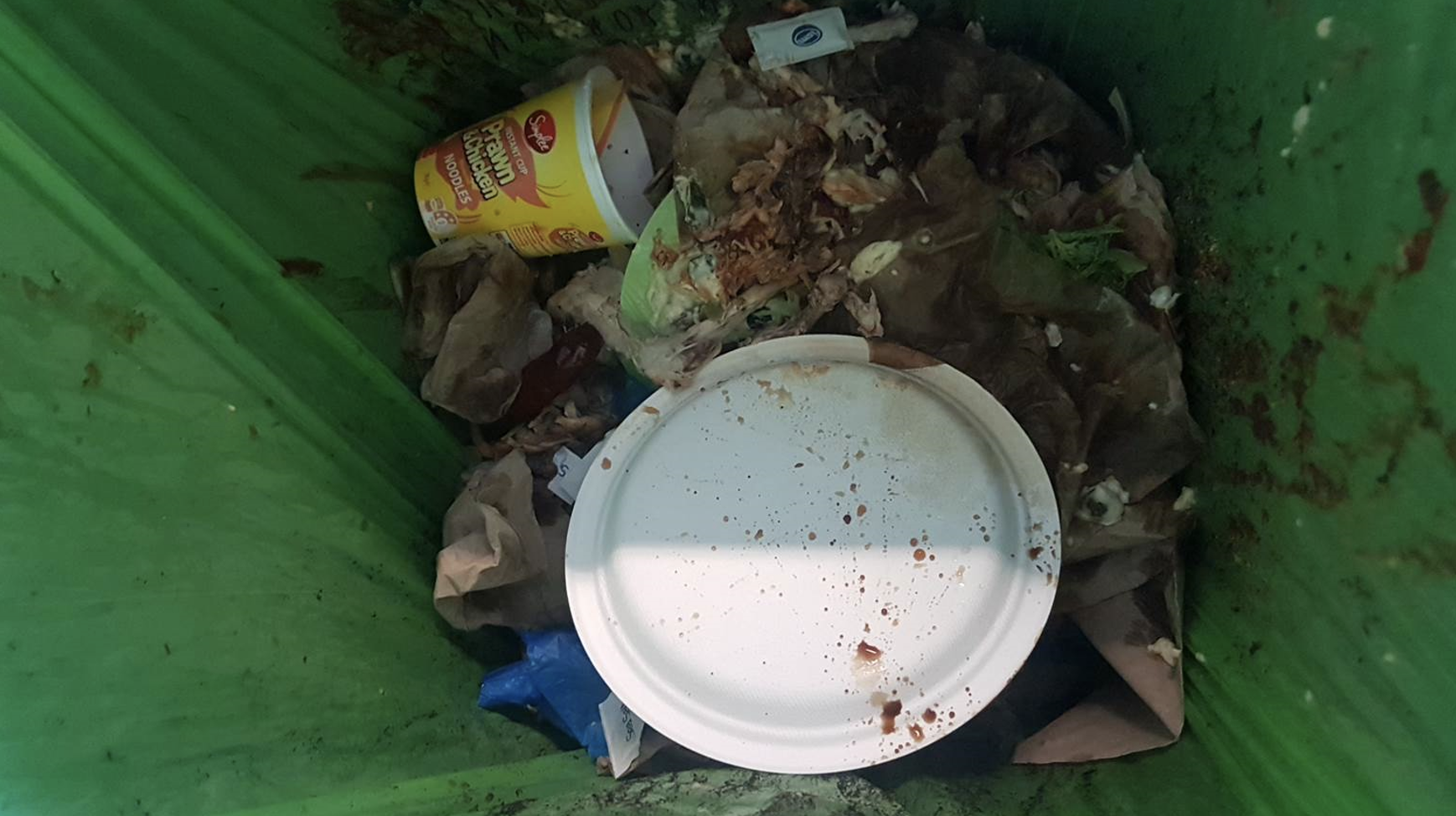
At the co-worker restaurant, the organic waste bin has plastic containers, gloves and plates.
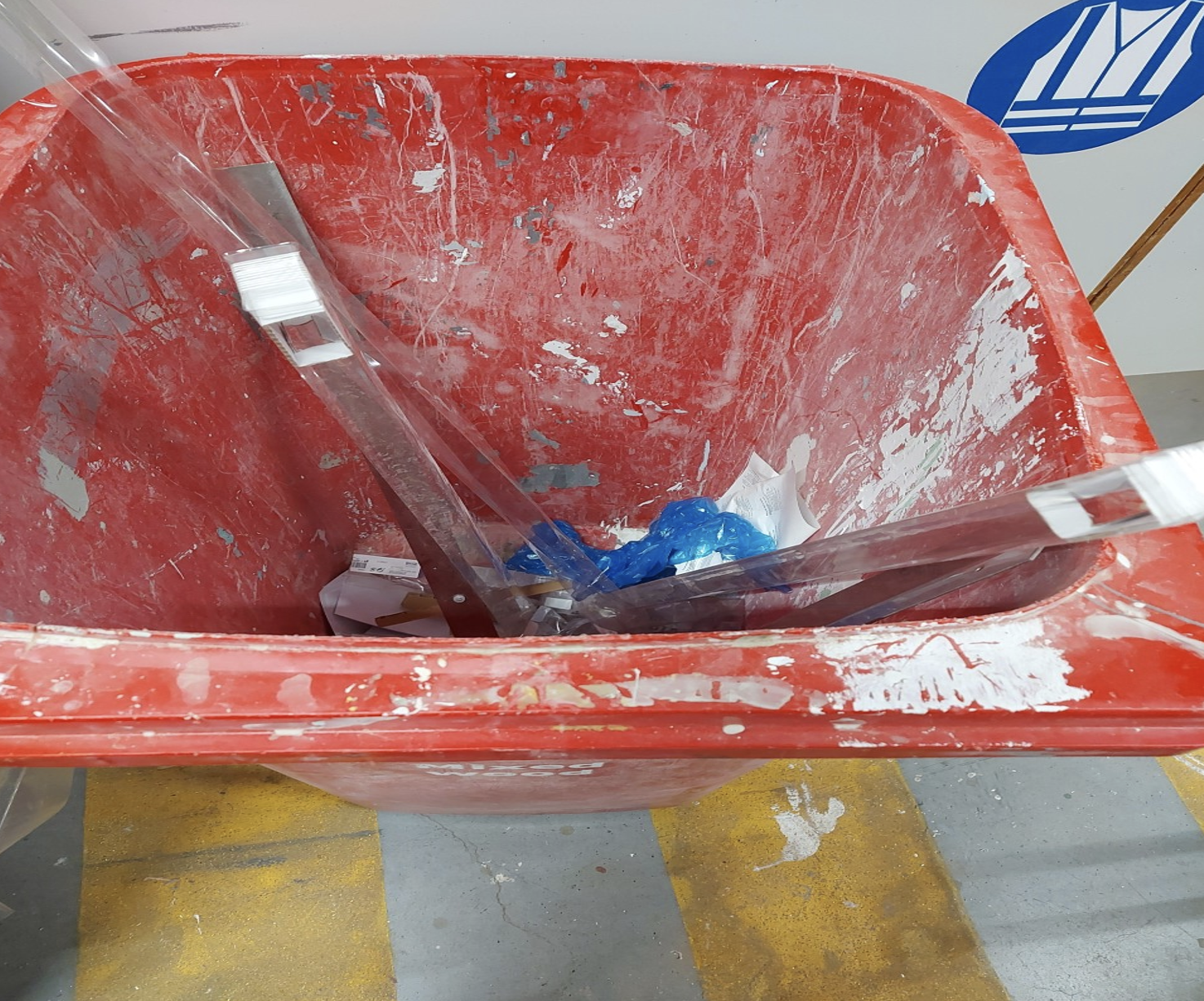
At the carpenter room, the waste bin that should be used for mixed wood only is being used to dispose metal and plastic.

At the loading dock area 1, the black coloured waste bin is used to dispose plastic food containers and bottles.
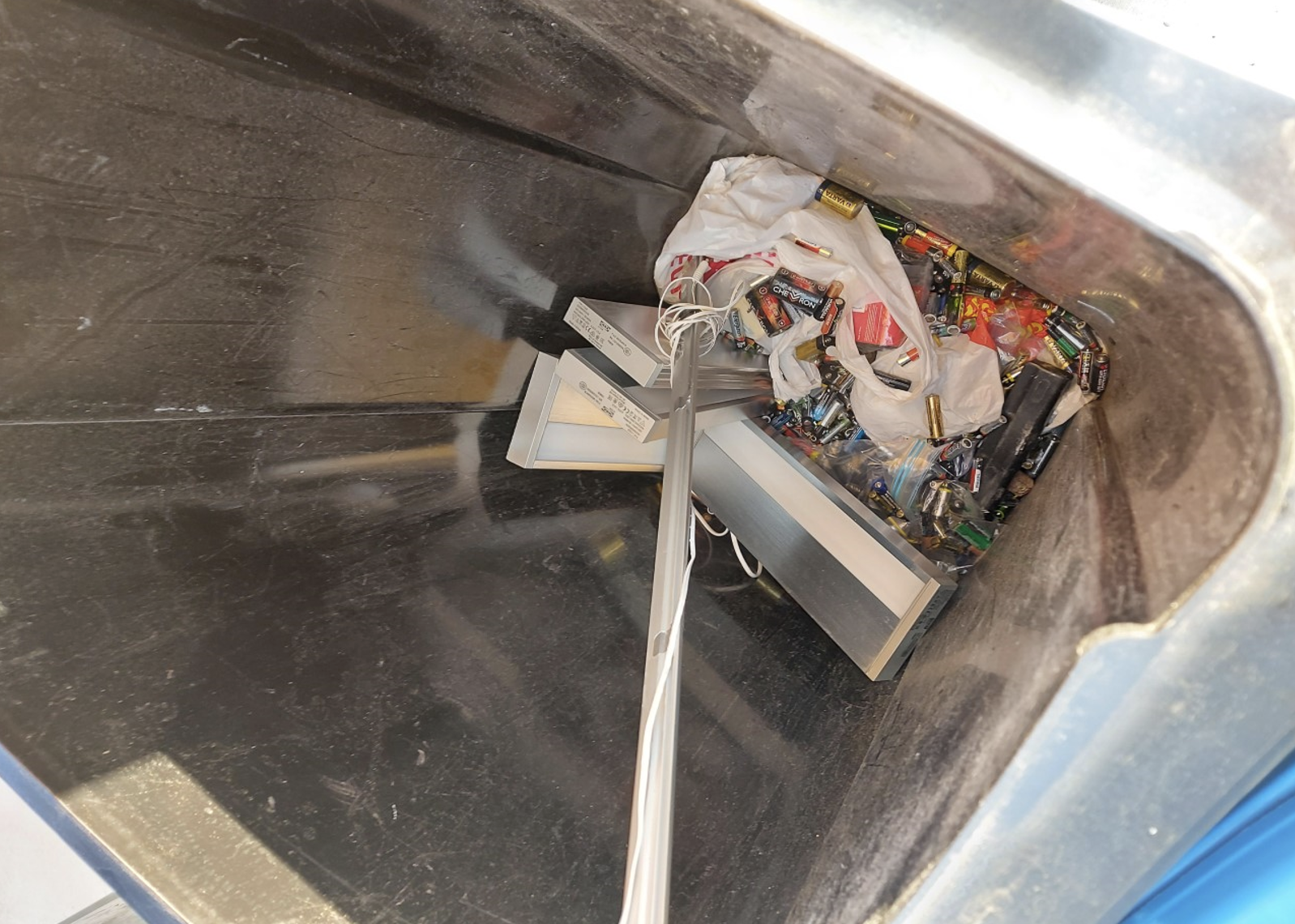
At the loading dock area 2, the black waste bin used to dispose batteries is contaminated with metal, wires and plastic.
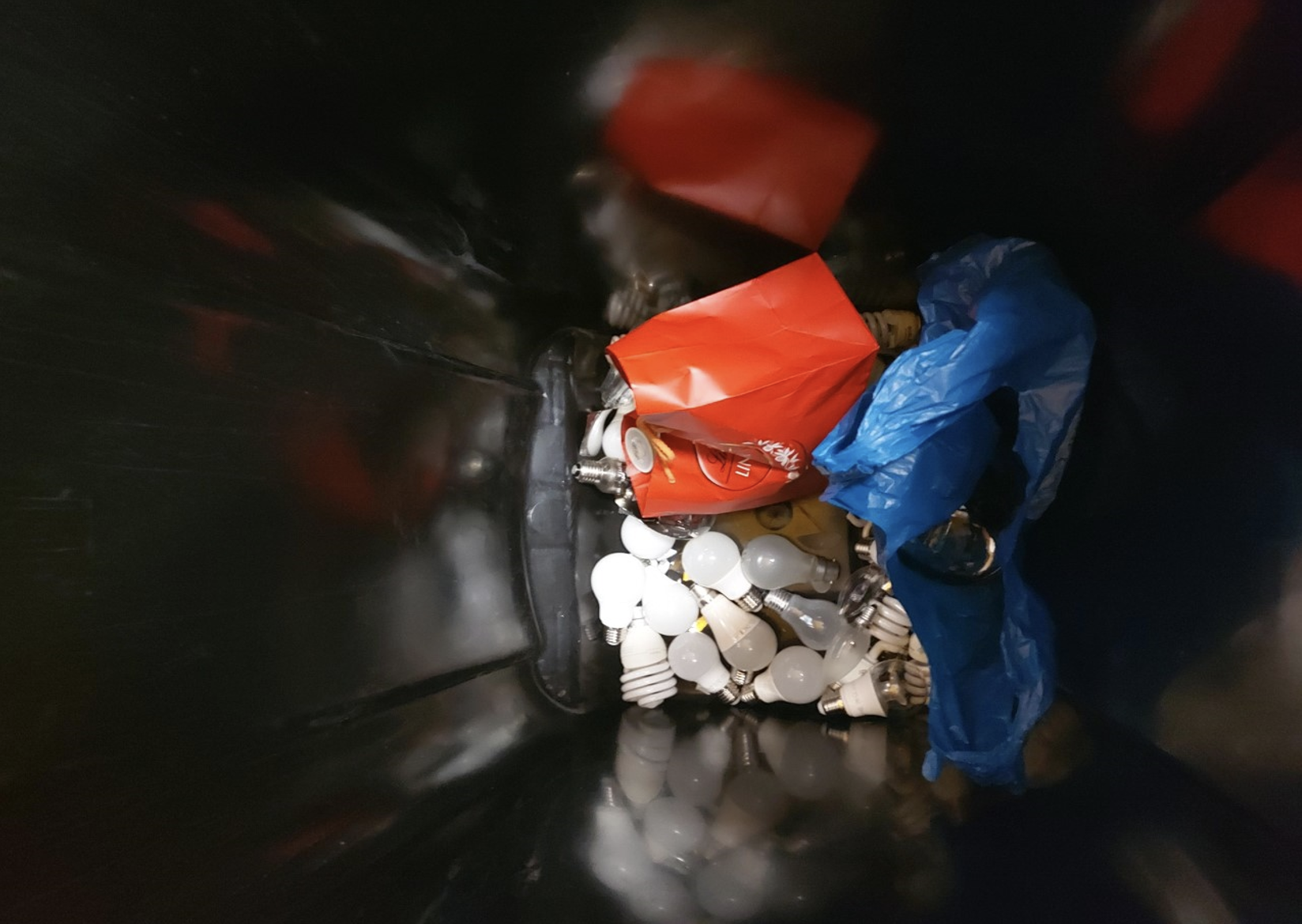
At the sales floor, the waste bin used to dispose glass bulbs is contaminated with plastic.

Richmond IKEA launches furniture donation and electronics recycling on Nov 28 by letting people to drop off their old furniture (and we see electronics) at a contactless drop-off point.
REFRAMING & VALIDATING THE PROBLEM
Poorly Informed Recycling Plan Causes Low Awareness & Dedication
We have a strategic design solution meeting with IKEA stakeholders.
We agree that IKEA has a comprehensive waste management handbook however the poorly informed recycling plan exacerbates the formation of low awareness of staff members.
The poorly informed recycling plan includes insufficient information about sorting recycling items, drop-off locations, and the ease of recycling at the workplace, which causes demotivation.
Although recycling is part of the workplace routine, no one is responsible for promoting active recycling. This includes the absence of incentives or rewards for recycling, which leads to low enthusiasm for workplace recycling.
Strategic design Zoom meeting with IKEA Australia: (From left) Head of Digital (Giovanni Rutigliano), Leadership and Competence Leader (Kent Eriksson), the Country Sustainability Manager (Melissa Miller), Country Sustainability Business Partner (Bhumika Selot), and Talent & Transformation Manager (Amber Pitty).
Based on the insights above, we developed the following design hypothesis:
By designing an intuitive and engaging recycling app for IKEA staff who are passionate about sustainability, employees will be able to easily identify which items can be recycled, where to recycle them, and how to do so correctly. This will make the experience feel encouraging and rewarding, increase staff participation in recycling efforts, and support IKEA’s goal of achieving zero waste.
The Birth of User Story
With the research, findings and reality check above to assist problem validation, the team reaches to an agreement that we are to provide users a digital experience through an app to address the following needs:
Know what / how to recycle
Aware of the location of the bins
Convenient, fast and motivated to recycle
I generate a user story to help creating a simplified, focused description of our design requirement. This is important in Agile software development to capture a description of a software feature from an end-user perspective:
As an IKEA staff who is excited about recycling,
I need an app to sort to recycle easily, knowing what, where, and how to drop items properly,
so that I feel encouraging, engaging and rewarding to use.
(For IKEA: To achieve zero waste)
THE EXPERIENCE SIMPLIFIED FOR GREATNESS
Introducing IKEA SORTED -
Sort Before Recycle
In an age where everything demands your time, especially when you are working, IKEA SORTED provides motivation to recycle within the workplace community. It simplifies the sorting of recyclables and makes the process of dropping them off quick, effortless, and rewarding.
Get On-board & Experience -
Sort, find, recycle, reward.
IKEA SORTED not only makes recycling more efficient but also helps you make informed decisions about sorting recyclables before you purchase any products. It provides clear and actionable information to guide you, helping to reduce waste that might end up in landfills.
If you can’t recycle it, don’t buy it. The choice is yours.

3 Ways to Sort - Just Sort & Drop
IKEA SORTED offers the convenience of sorting recyclables based on visual cues. You can either scroll through and find your recyclables, scan or enter the product code, or upload a photo and let the app guide you on where the recyclables should go.
Once you've sorted the item, an informative panel will tell you which bin to use for disposal. This step is crucial as it ensures that recyclables are correctly sorted from the start, thus reducing the amount of waste that ends up in landfills.

Track & Find the Bins.
Get Instant Reward.
IKEA SORTED helps you find the optimal place to drop your recyclables by locating the nearest bin based on your current location and destination. It saves you time by removing the need to decide where to dispose of your recyclables.
You can track and trace your recycling activities in two ways: using the location tracker or by entering your branch location manually.
People-friendly walking instructions guide you to your recycling spot, eliminating delays and hesitation.
After scanning the bin and disposing of your recyclables, you’re eligible for instant rewards. Redeem them for items like reusable products or treat yourself to the famous meatballs at the IKEA café.
The more you sort and recycle, the more perks you earn.

You Create the Journey.
You are the Community.
You are not alone.
Once you start the journey of sorting and recycling, you become part of a community—a network where you can see how others are participating and give kudos for their efforts.
You can either scroll through and find your recyclables, scan or enter the product code, or upload a photo and let the app sort the recyclables for you.
After sorting the item, an informative panel will guide you on which bin to use for disposal. This step is crucial as it ensures appropriate recycling, thereby reducing the waste that ends up in landfills.
“I really enjoy your storytelling and
how you brought design thinking to life.
Well done!”
- Giovanni Rutigliano, IKEA Australia - Head of Digital
HOW WE GOT THERE
Creating the Perfect Digital Recycling Experience for Everyone, Everywhere
Three primary questions informed my design strategy:
How do you design for everyone, everywhere?
What contexts need to be considered?
What’s the perfect digital recycling experience?
I refer to the waste hierarchy as stated in IKEA waste management handbook to reframe our conversations with the stakeholder about recycling practice and actual recycling behaviour from the staff members.
This framework helped shift the focus from unproductive questions like "How can we prevent more waste from going to landfill?" to more productive ones like "How might we create an experience designed to ensure appropriate recycling from the start?".
The waste hierarchy model as depicted from the IKEA waste management handbook.
Working Backwards for Futures Thinking
I started by examining the root causes of the problem and addressing the challenges of recycling.
While dealing with waste can be painful, and often too late to prevent landfill contributions, I realised that as you progress through the waste hierarchy, the challenges associated with recycling decrease.
To stimulate creativity, I reversed the focus of the waste hierarchy.
I discovered that reducing waste before recycling is relatively easy, making the recycling process less painful at this stage.
This led me to consider: What if we design a solution that addresses the root cause of the problem from the beginning, before it's too late?
It is a biggest pain to talk about recycle from ‘landfill’ as landfill is the final controlled disposal of waste onto land. It blocks the mindset to start recycle again.
I reverse the waste hierarchy and realise the pain of taking action to recycle is the lowest from the waste reduction stage. It opens up mindset for actionable recycling.
Putting my Futures Thinking Hat on
I read a quote and it triggers my futures thinking:
If you want to understand the causes that existed in the past, look at the results as they are manifested in the present.
If you want to understand what results will be manifested in the future, look at the causes that exist in the present.
The effect is the result of your cause.
I continued to delve into the root causes of the problem. Three key design challenges emerged:
What are the 15% of waste that ends up in landfills? (The effect)
Why do we mix items up in the first place? How can we sort them before recycling? (The cause)
How can we become better informed about appropriate recycling in the future? (The future)
The question, "Why do we mix items up in the first place? Can we address this issue before mixing occurs with the app we are designing?" kept resonating throughout my design thinking process.
I then realised that if recyclables could be 'SORTED' properly from the beginning, the 15% of waste going to landfills could be reduced over time.
Thus, I introduced an additional step in the process, termed 'SORT.'
And so, the concept of IKEA SORTED was born!
Working Backwards from Sustainability
I reversed the focus of the imperfect recycling practice at IKEA, leading to four key design challenges:
How might we improve recycling practices to ensure appropriateness?
How might we create a recycling process that minimizes effort and saves time?
How might we effectively inform users about recycling drop-off locations using a map?
How might we better engage the workplace community to sustain recycling practices?
FROM INEFFICIENT TO OPTIMISED
4 Ways to Sort Without Thinking - Making Recycle Fast, Easy & Rewarding
Digging into the data revealed significant insights into the workplace recycling experience. Nearly all recycling journeys involved extra searching, locating, and accessing. It required additional physical effort, such as walking to a different location to drop off recyclables.
According to the survey:
67% of people stop recycling because they don’t know what and how to recycle.
33% find recycling time-consuming.
71% would start recycling if they had an app providing more information on what happens to recycled materials.
This data indicates that the appropriate recycling experience has not been effectively informed or optimised for accessibility.

Wireframing for on-boarding and scrollable sorting

Mobile app UI design for "Sorted by IKEA" showing onboarding steps for recycling: design alignment, scanning items, finding bins with GPS, sorting recyclables, and joining a leaderboard for rewards.
FROM INCONVENIENCE TO INSTANT
Giving Staff Members Back Their Time to do Recycle Immediately
Understanding the user’s goal of sorting recyclables and accurately locating the recycling bins allowed us to handle the heavy lifting and select the most optimal interaction.
The app needed to be smart enough to enable users to scroll and sort recyclables easily, and efficient enough to provide immediate information on recycling drop-off locations to encourage actionable practices.
I conducted immersive research, where users interacted with the MVP to find bins, sort, and recycle while holding a recyclable in hand. This helped identify which cues or heuristics could be introduced into the ‘recycling adaptation’ to give participants a sense of experiencing recycling in a real workplace setting.
This ‘recycling adaptation’ system was the most complex problem of the project.
Immersive Research & Adaptation Design Based on Not Just Empathy but Compassion
Foundational to the adaptation framework were these concepts:
We needed to address user needs to sort recyclables quickly and intuitively. Users should be in control of the recyclables, with design patterns allowing one-handed scrolling (since they may hold the recyclable with the other hand) while searching for bins. The entire recycling journey must be fully manageable by the user.
The system needed to be well-informed about the availability and location of bins, including the colours of the bins for appropriate sorting.
The system needed to be flexible and motivating, encouraging users to engage continuously. The design should not only be based on empathy but also on a deep compassion for recycling.

Before: Horizontal visual cue search design

Iteration: Vertical visual cue search design (made easy for thumb scrolling)

Image showing a mobile app interface for sorting waste and recyclables. The app features options to scan or upload images of items to sort, displays items like drinking cups in trash, and includes functionality for identifying bin color. Visible are vertical sorting cues and a navigation bar optimized for thumb use.
FROM AMBIGUOUS TO OBVIOUS
Better Informed Accessibility & Availability, with Perks
The map tracker not only locates and traces nearby bins but also indicates the colours of the bins available on-site, making immediate recyclable sorting actionable.
To enhance the recycling experience, actions are incentivised with rewards such as exchangeable items, refillables, or food from the IKEA café. Points are collected and notified instantly, allowing for immediate redemption.

Wireframing for bin locator, bin scan and points collection

A visual guide displaying a mobile app interface for locating and using recycling bins. The sequence shows starting by finding nearby bins, viewing bin locations on a map, scanning bin QR codes for recycling details, earning recycling points, and redeeming points for rewards. Yellow and black icons and text are used throughout the interface.
FROM INDIVIDUAL TO COMMUNITY
You Build the Community While You Create the Journey
The journey of a thousand miles begins with a single step.
No individual effort in recycling should be overlooked. Therefore, I designed a system to turn personal efforts into community awareness. The key to achieving this is to create a leadership board-like panel where everyone can give kudos to each other for their contributions.

Wireframing for scrollable leaderboard

App interface showcasing features like bin location search by store, geo-tracker for finding bins, scrollable recycling leaderboard, and personal profile with points and editing options.
THE OMNI-EXPERIENCE
One Simple Goal that Utilises Omni-interaction
IKEA SORTED features a user flow designed to keep users engaged at every point of their recycling journey. Users can continue their recycling activities seamlessly at any touchpoint.
In short, it places the user at the centre of the design solution while meeting business objectives. The interaction is crafted to unify the experience, motivating users to complete their entire recycling journey rather than merely clicking on the app, walking to the bin, or sorting recyclables.
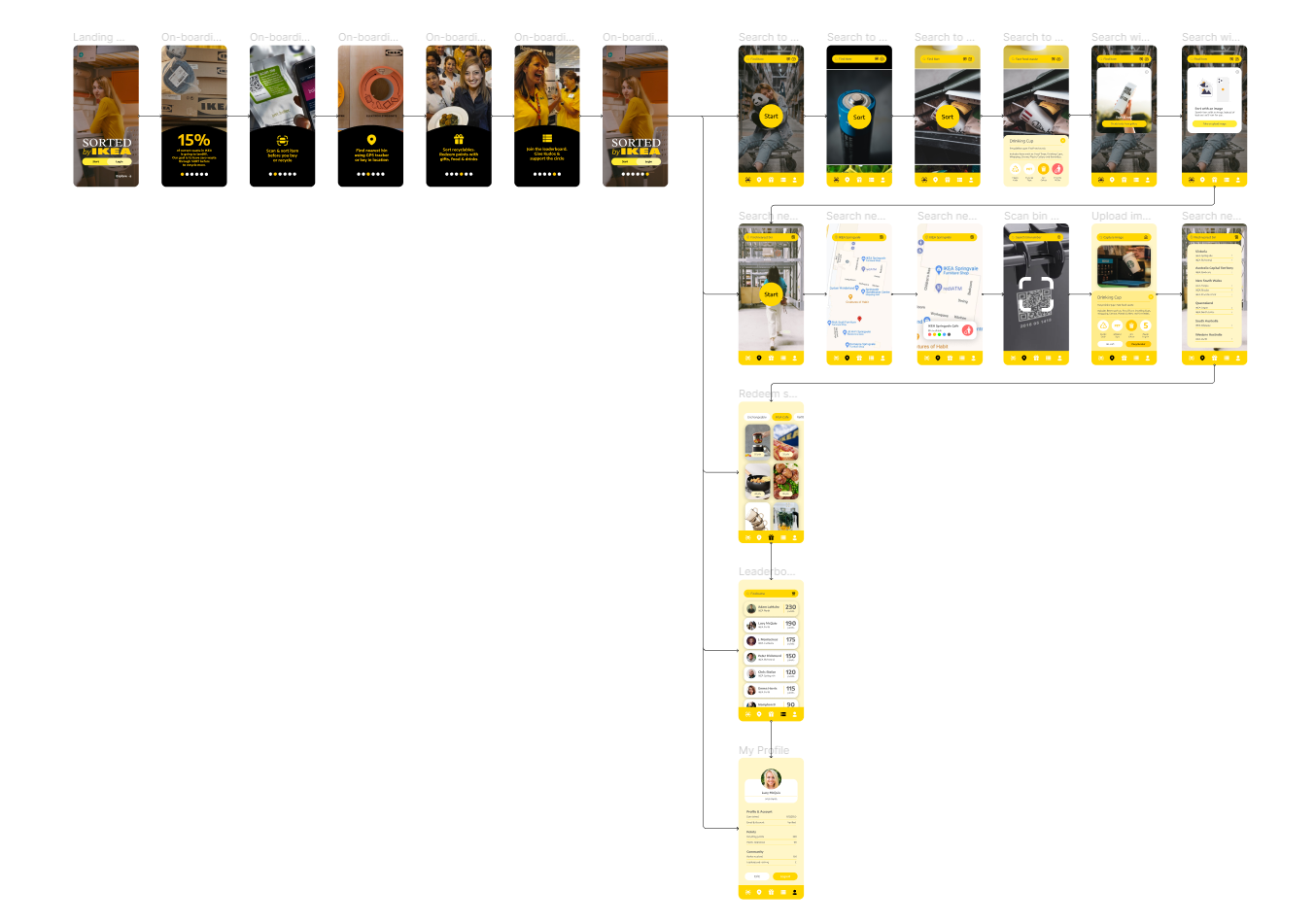
THE LAUNCH
The Most Radical Update Since 2017
In the 6 months after my involvement on the project, the team continued to evolve and polish the visual design, as well as finesse the finer functional details as the app was being built. Although I was not part of this process, it was great to see most of my work brought to life using visual key search.
On 3rd February 2021, the app ‘IKEA PLACE’ was updated to version 4.2.2 with updates include loading visual furniture and design system optimisation that is closer to the concept and visual design of ‘IKEA SORTED’ — an impressive achievement by the team, considering that it was a complete redesign and rebuild from scratch. This design platform will be used by the DevOps to further develop IKEA SORTED.
THE IMPACT
IKEA SORTED gets further development
On 3rd February 2021, the app ‘IKEA PLACE’ was updated to version 4.2.2 with updates include loading visual furniture and design system optimisation that is closer to the concept and visual design of ‘IKEA SORTED’ — an impressive achievement by the team, considering that it was a complete redesign and rebuild from scratch.
This design platform will be used by the DevOps to further develop IKEA SORTED.



















